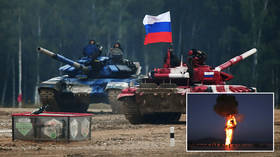Western WWIII game plan revealed? Analysts say Poland could win Russia-NATO war by invading Kaliningrad & securing Moscow’s nukes

An all-out war between Russia and the West would be decided by bloody fighting in the picturesque Baltic Sea exclave of Kaliningrad, American analysts say in a study that gives rare insight into how a new world war might play out.
The military journal Overt Defense published an article in late January describing how Russia’s westernmost province, home to half a million people, would become the site of a fierce stand-off if the country comes to blows with Western nations. It notes that Moscow stations tens of thousands of troops in the region, as well as battalions of Iskander short-range ballistic missile launchers capable of delivering nuclear payloads against cities in Germany, Poland and the Czech Republic.
In 2018, as Russia was hosting the football World Cup, a US watchdog issued a warning over the country’s nuclear capabilities in Kaliningrad, one of the tournament’s host cities. The Federation of American Scientists published satellite photos they described as showing expanded capacity at a reinforced bunker they alleged to be a storage site for warheads. “It’s a site we have been monitoring for quite some time and there have been some upgrades in the past but nothing as dramatic as this one. This is the first time we’ve seen one of the nuclear bunkers being excavated and apparently renovated,” a spokesman said.
According to the doomsday scenario plan for a full-scale war, the analysis says, NATO member Poland would have to storm into the breach and do it quickly enough to prevent a nuclear exchange. They say that the 45,000 active soldiers in Warsaw’s army would have to overcome the 50,000-strong Kaliningrad garrison and seize control of the facilities before Russian defenders could press the big red button.
Also on rt.com Belarus risks angering US over order of advanced Russian S-400 missile system that has sparked worries for NATO warplanesWhile there would be numerous obstacles to this plan in practice, the article spells out one as the most significant. Russia’s S-400 air defense system has been hailed as among the most advanced in the world, and reportedly such a threat to NATO warplanes that Washington has sought to impose sanctions even on members of the military bloc, like Turkey, who have sought to purchase it from Moscow. Without air supremacy, it is hard to see how Poland could prevail in a ground-based blitzkrieg.
However, residents of Kaliningrad might not be sleeping soundly for long. According to the Overt Defense analysis, “the Polish Air Force is working on a solution against” the high-tech launcher. While no detail is given on the shadowy project, the author concedes that “it will take a while to introduce it.”
The playbook describes the likelihood of Poland being able to mobilize its forces quickly enough for a preemptive strike as “optimistic but possible.” The authors contend that “speed and surprise would be essential,” as “the Polish Armed Forces position is not an easy one to begin with.”
While the scenario is hardly likely to make Russian generals wake up in a cold sweat, there is, perhaps, a precedent in history. At the height of its power, the colossal Polish-Lithuanian Commonwealth, which spanned from Latvia to modern-day Ukraine, was one of the few nations ever to successfully conquer Moscow in a land invasion. In 1610, its forces entered the Russian capital and set up shop in the Kremlin, which they held for a year before being starved out by their enemies.
Of course, Poland’s elite troops at the time consisted of the dreaded Winged Hussars, a crack cavalry squadron who wore feathers on their armor to create the whistling noise of a swooping bird as they charged. They would have been unconcerned about the prospect of being shot out of the sky by a Russian-made S-400 missile launcher.
Think your friends would be interested? Share this story!














